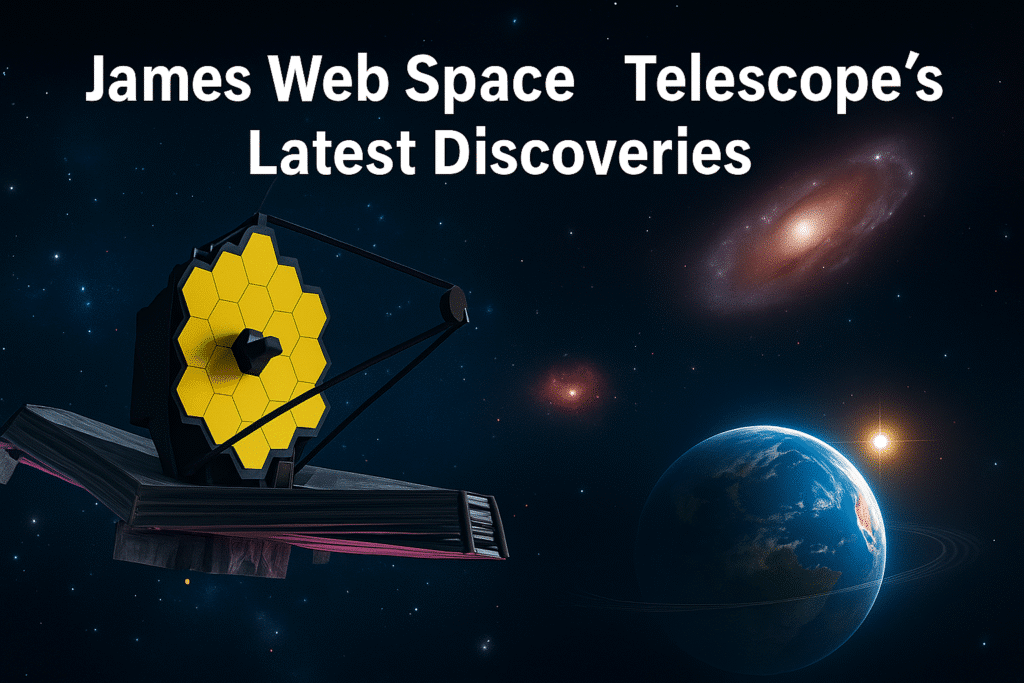The James Webb Space Telescope (JWST) has opened a thrilling new chapter in humanity’s exploration of the cosmos. Since its launch, this engineering marvel has been delivering jaw-dropping images and groundbreaking scientific data that are transforming our understanding of the universe. With its powerful infrared vision and unmatched precision, JWST is giving scientists the ability to peer deeper into space—and further back in time—than ever before.
From capturing light from the earliest galaxies to detecting signs of possible habitability on distant exoplanets, JWST’s discoveries are nothing short of revolutionary.
The Telescope That Sees the Invisible
Unlike the Hubble Space Telescope, which mostly observes visible and ultraviolet light, JWST specializes in infrared astronomy. This is crucial because many of the most distant or dust-obscured objects in the universe emit most of their light in infrared wavelengths.
Infrared light can pass through clouds of gas and dust that block visible light, allowing JWST to reveal phenomena previously hidden from our view. This means we can now study star formation regions, distant galaxies, and planetary atmospheres with unprecedented clarity.
Its mirror—over 6.5 meters wide—collects more light than any previous space observatory, giving scientists the ability to spot incredibly faint objects billions of light-years away. In effect, JWST is like a cosmic time machine, showing us snapshots of the universe as it was over 13 billion years ago.
Peering Into the Dawn of Time
One of JWST’s most spectacular achievements is capturing images of galaxies formed shortly after the Big Bang. By observing light that has traveled across the universe for billions of years, the telescope is providing insights into what the cosmos looked like in its earliest stages.
In its first year of operations, JWST identified galaxies that are potentially older than previously thought possible, challenging existing theories of galaxy formation. The telescope’s deep-field images—densely packed with thousands of galaxies—have revealed that the early universe was more dynamic and structured than scientists expected.
These discoveries are not just visually stunning; they help astrophysicists understand:
- How the first stars ignited
- When heavy elements began to form
- How early galaxies merged and evolved
Every observation adds a new piece to the puzzle of cosmic evolution, bringing us closer to understanding how the modern universe came to be.
Hunting for Habitable Worlds
Beyond galaxies, JWST is making headlines for its work on exoplanets—planets orbiting stars beyond our solar system. One of its most powerful tools is its ability to analyze exoplanet atmospheres.
By observing how starlight filters through a planet’s atmosphere during a transit (when the planet passes in front of its star), JWST can detect chemical signatures such as:
- Water vapor
- Methane
- Carbon dioxide
- Oxygen
These chemicals are considered “biosignatures” when found in certain combinations, as they could indicate the presence of life or life-supporting conditions.
Already, JWST has observed planets like WASP-96 b, a giant gas world, and detected the clear presence of water vapor—proof that its instruments are capable of performing these delicate measurements. The telescope is also targeting smaller, rocky exoplanets that are more similar to Earth, in hopes of finding worlds within the habitable zone—where liquid water could exist.
Rewriting Our Cosmic Story
Every image and dataset from JWST is more than just a scientific achievement—it’s a challenge to what we thought we knew. For example:
- Some galaxies spotted by JWST appear surprisingly massive and well-formed for their age, forcing scientists to reconsider models of galaxy growth.
- Observations of distant star-forming regions show a different pace of stellar birth than expected, reshaping theories of how quickly stars can form in young galaxies.
In essence, JWST is redefining timelines for how the universe matured, suggesting that cosmic evolution might have been faster and more complex than previously believed.
The Technology Behind the Magic
The James Webb Space Telescope is a masterpiece of engineering, designed to operate a million miles from Earth at a point known as Lagrange Point 2 (L2). This position keeps it in a stable orbit with minimal interference from Earth’s heat and light.
Some key features include:
- A massive gold-coated mirror for maximum infrared sensitivity
- A five-layer sunshield the size of a tennis court to keep its instruments cool
- Advanced spectrographs and cameras to capture and analyze light in incredible detail
Operating at just a few degrees above absolute zero, JWST’s instruments must remain perfectly aligned and shielded to function. Every observation is a product of extreme precision, teamwork, and decades of planning.
Beyond Astronomy: Why This Matters to Us
While JWST’s primary mission is scientific, its impact goes far beyond the realm of astrophysics. Its discoveries influence:
- Philosophy: Expanding humanity’s perspective on our place in the cosmos
- Technology: Driving innovation in optics, materials science, and data processing
- Education: Inspiring future generations of scientists and engineers
- Collaboration: Showcasing the power of international cooperation in science
In the search for potentially habitable worlds, JWST also plays a role in one of the most profound questions ever asked: Are we alone in the universe?
What’s Next for JWST?
The telescope’s mission has only just begun. Future plans include:
- Studying the atmospheres of Earth-like exoplanets in nearby star systems
- Mapping the birthplaces of stars in unprecedented detail
- Investigating the supermassive black holes at the centers of distant galaxies
- Monitoring the chemical evolution of the universe over cosmic time
Each of these goals brings us closer to answering questions about the origins of life, the structure of the cosmos, and the ultimate fate of our universe.
A Legacy in the Making
The James Webb Space Telescope is more than a successor to Hubble—it’s a leap forward in humanity’s quest to understand the universe. Its ability to see further, detect fainter objects, and analyze atmospheres of alien worlds marks a historic turning point in space science.
As more discoveries roll in, JWST will continue to surprise us, challenge our theories, and inspire wonder. It’s a reminder that even in a universe so vast and ancient, our curiosity can light the way to new knowledge.
With each new revelation, we are not just learning about stars and planets—we are uncovering the story of everything. And in that story, we may yet find the answers to questions as old as humanity itself.





